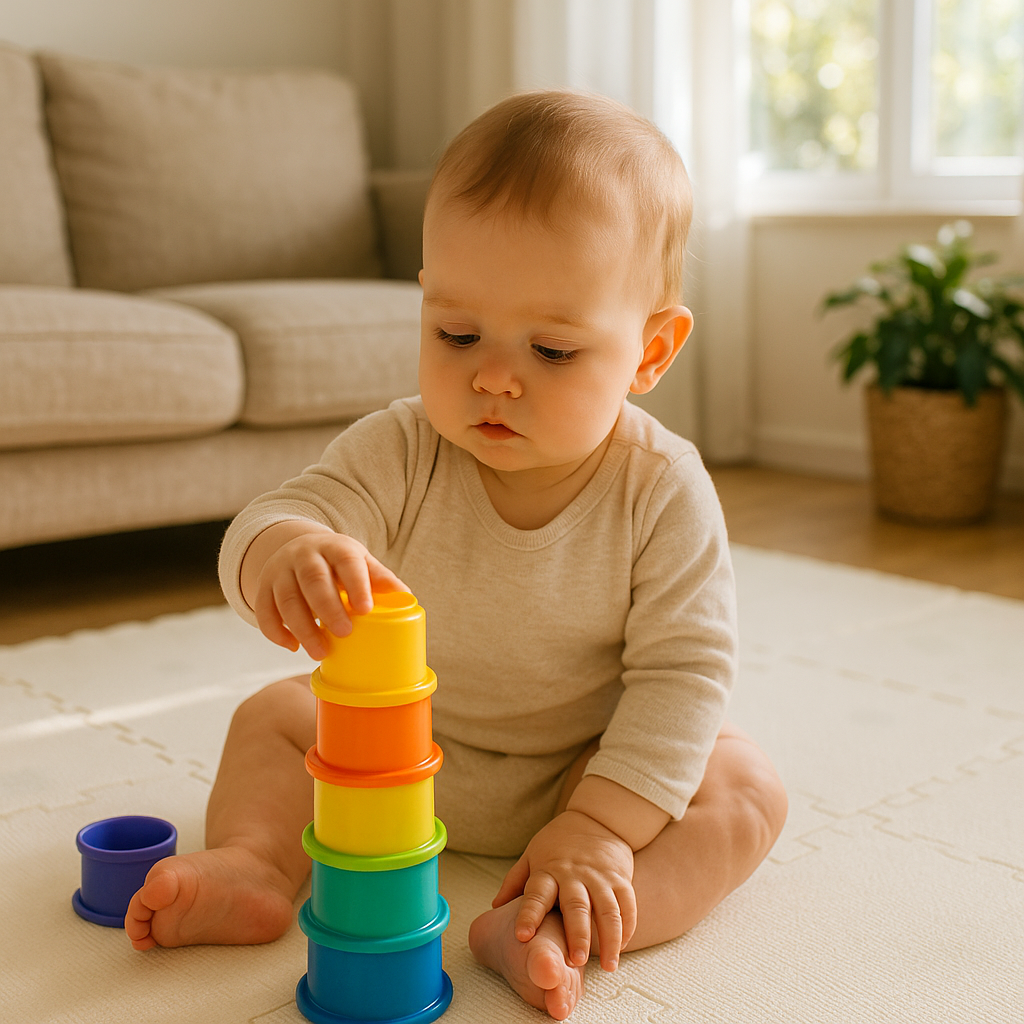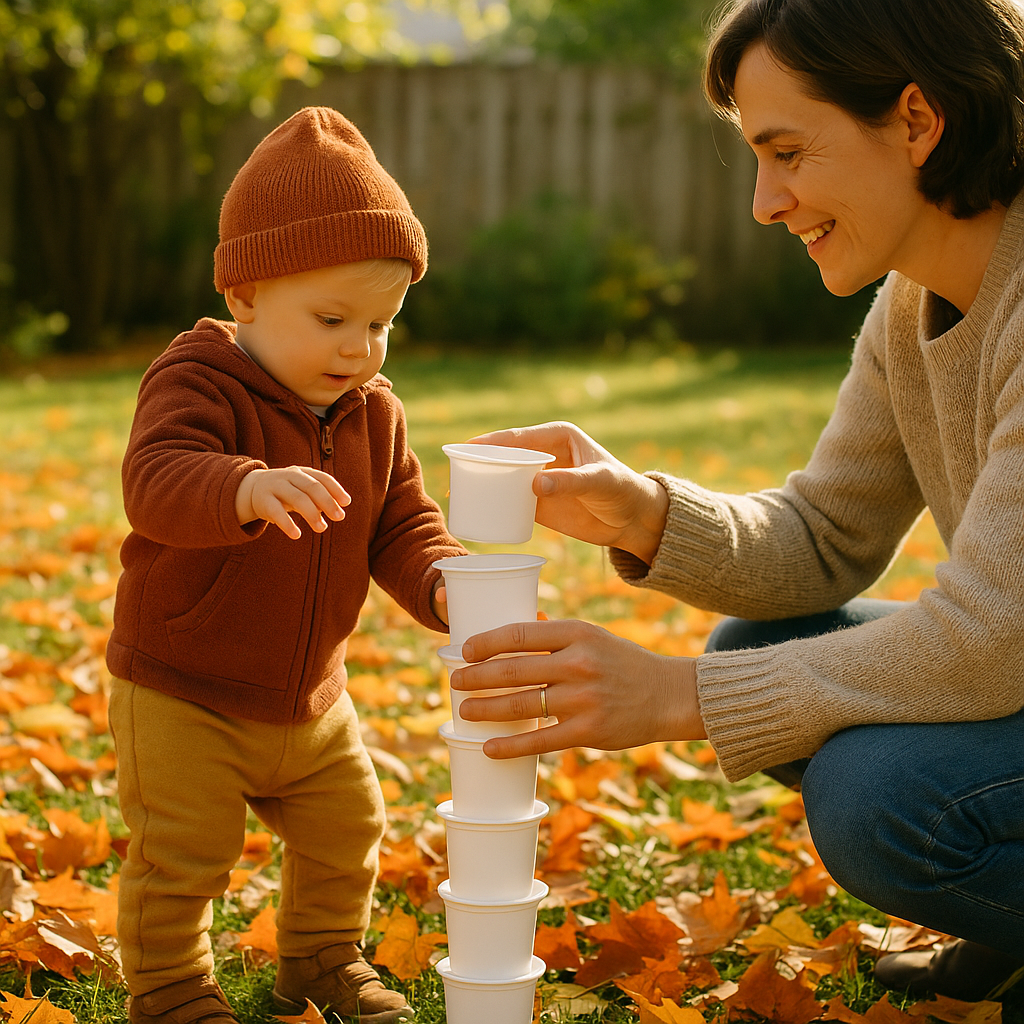Every time your baby stacks a tower of blocks or nests a set of cups, they’re not just playing—they’re building their brain. These simple activities are crucial for developing spatial intelligence, the ability to understand and visualize the world in three dimensions. Spatial skills are foundational for math, engineering, and everyday problem-solving, and you don’t need fancy toys to foster them. Everyday objects like blocks and cups can work wonders when paired with intentional play and language.
- Why are blocks and cups the easiest tools for building spatial intelligence in babies?
- When do babies start stacking or nesting, and which milestones should I watch?
- How does block-and-cup play actually build the brain beyond spatial skills?
- How can I adapt blocks and cups for every budget, ability, and culture?
- What age-by-age play ideas will supercharge my baby’s spatial growth?
- How can I use spatial language to double the learning during play?
- What if my child isn’t stacking yet? Red flags and next steps
- Quick-Fire FAQ: Your Top Questions Answered
- Final Thoughts
Why are blocks and cups the easiest tools for building spatial intelligence in babies?
Blocks and cups are ideal for building spatial intelligence in babies because they’re open-ended, allowing endless ways to stack, align, or nest without a single “correct” outcome. This freedom lets babies practice intrinsic spatial skills (like rotating a block) and extrinsic skills (like placing one cup beside another). According to the CDC’s developmental milestones, 75% of children can stack two blocks by 15 months, marking a key cognitive milestone. A 2021 study on block play found that such activities foster spatial language, which predicts stronger spatial skills in preschoolers. Unlike screens, hands-on play engages sensorimotor circuits and promotes synaptic pruning, strengthening neural pathways critical for math and problem-solving.
See how active play outshines passive viewing in Play vs. TV.

When do babies start stacking or nesting, and which milestones should I watch?
Babies typically progress through stacking and nesting milestones as follows:
- 7–9 months: They mouth, bang, and drop blocks, exploring textures and sounds.
- 10–12 months: They place one object on another, achieving their first true “stack.”
- 16–18 months: Most can build a 2–3 block tower, mastering balance.
- 18–24 months: They stack 4–6 blocks or fit a full set of nesting cups, understanding depth.
Stacking develops balance and height, while nesting teaches depth and enclosure, both strengthening neural connections in the hippocampus. The CDC’s developmental milestones confirm that 75% of children stack two blocks by 15 months. Rounded cups or rings are easier for beginners due to stable bases. For age-matched activities, check Boost Your Baby’s Brain Power.
How does block-and-cup play actually build the brain beyond spatial skills?
Block and cup play strengthens fine-motor control and graded force, skills crucial for writing, as stacking requires precise pressure similar to pencil grip muscle memory. Using spatial language—words like “between,” “under,” or “inside”—boosts cognitive development. Narrating play, like saying, “The small cup goes inside the big cup,” reinforces resilience and cause-and-effect learning when towers fall, engaging the hippocampus and promoting neural connections. For more cause-and-effect activities, explore Cause-and-Effect Play.
How can I adapt blocks and cups for every budget, ability, and culture?
Block and cup play is highly adaptable to suit diverse budgets, abilities, and cultural contexts:
- Budget-friendly: Use household items like yogurt tubs, spice jars, or cardboard boxes as “household manipulatives” for stacking and nesting, making play accessible without costly toys.
- Accessibility: Choose oversized foam blocks for babies with limited grasp strength to ease motor challenges, or use high-contrast cups for those with low vision, pairing well with activities like High-Contrast Books.
- Inclusivity: Incorporate floor-level play near a mirror during tummy time to enhance proprioception, a practice that fits various cultural settings and aligns with benefits outlined in Tummy Time Benefits.

What age-by-age play ideas will supercharge my baby’s spatial growth?
Try these age-specific play ideas to boost your baby’s spatial growth and strengthen neural connections:
- 6–9 months: Bang wooden blocks in a metal bowl to explore sound and spatial depth, engaging sensorimotor circuits. This helps babies understand object relationships through auditory feedback.
- 9–12 months: Offer two soft silicone bricks on a high-chair tray; celebrate their first stack to encourage intrinsic spatial skills like balance. Simple setups build confidence.
- 12–18 months: Play a “tower race” to stack three blocks, counting each layer aloud to reinforce number and height concepts, supporting extrinsic spatial skills.
- 18–24 months: Build a “cup city” by bridging blocks over nested cups, introducing words like “over” and “through” to enhance spatial language.
Adding music, like singing nursery rhymes during play, can further boost spatial-temporal skills. For more creative variations, check out Messy Play.
How can I use spatial language to double the learning during play?
To maximize learning during block and cup play, use spatial language—words like “inside,” “under,” “beside,” “adjacent,” “nest,” and “pile”—to describe actions and positions. For example, say, “The small cup goes inside the big cup—now it’s under my hand!” This reinforces spatial intelligence and builds neural connections linked to math skills. Parents may use less spatial language with daughters at age 4.5, so ensure language parity for all children. Singing position words in Nursery Rhymes keeps it playful and engaging, enhancing language acquisition and cognitive growth.
What if my child isn’t stacking yet? Red flags and next steps
If your child isn’t attempting to stack objects by 15 months, it may be a red flag. Discuss this with your pediatrician, who may recommend an occupational-therapy screening to assess fine-motor control or spatial skills. Meanwhile, simplify the task: offer large, lightweight foam cubes to reduce precision demands and encourage exploration. A self-paced shelf setup, as suggested in Montessori for Babies, can also spark interest. Variation is normal—praise effort to build confidence and support neural connections. If concerns persist, early intervention can address delays effectively. For more developmental tips, explore Boost Your Baby’s Brain Power.
Quick-Fire FAQ: Your Top Questions Answered
-
Are expensive educational sets necessary?
No; everyday items like yogurt tubs or boxes foster spatial intelligence and fine-motor skills when paired with hands-on, language-rich play. -
Is knocking towers down okay?
Yes; it teaches gravity, persistence, and cause-and-effect, strengthening neural connections critical for problem-solving. -
How long should sessions last?
Aim for 5–10 minutes for infants; engaged toddlers can stretch to 20 minutes to maximize sensory play benefits. -
Safety checklist?
Use pieces larger than 1.6 inches (4 cm) to prevent choking, choose BPA-free plastics or unfinished wood, and inspect for sharp edges to ensure safe exploration. -
Can music enhance play?
Absolutely; singing during play boosts spatial-temporal skills, adding a fun cognitive lift.
Final Thoughts
Blocks and cups show that the simplest toys can spark massive brain gains. Just a few minutes of spatial play, paired with rich talk like “under” or “beside,” builds neural connections that boost confidence in math, science, and everyday problem-solving. caregiver interaction during play enhances spatial intelligence even more.
Fun fact: your enthusiastic narration can increase your baby’s engagement by up to 20%, per recent research! Download our printable play chart from 10 Sensory Play Ideas and watch those tiny towers grow into giant leaps of learning.